Favorite bee-pollinated cucumber variety “Elegant” by gardeners for growing in greenhouses and open ground
The Graceful cucumber is one of the oldest varieties in the state register. It has gained popularity among gardeners for its tender and crispy pulp, unpretentiousness, and early ripening. Designed for cultivation in open ground, has a commercial purpose, and does not require the skills of a professional in the field of agricultural technology. The article will tell you what kind of variety this is and why it has been popular among our farmers and summer residents for almost 50 years.
Characteristics and description of the variety
The Graceful cucumber was bred by breeder O.V. Yurina in the 60s of the last century. In 1971, the variety was included in the State Register. It is grown in all regions of the country (from the central regions to the Far East).
Russian gardeners prefer to grow this particular variety. Despite the abundance of new crops, the Graceful cucumber has not lost its significance, and this says a lot.

Distinctive features
Graceful - early ripening variety. The first fruits appear 45 days after the seeds sprout.
Belongs to bee pollination. The cucumber produces male flowers, thanks to which the bushes act as a pollinator for other varieties. The plant tolerates frost well, which makes it suitable for planting in open ground at the earliest possible date.
However, the culture is not without its shortcomings. These include: average yield, the presence of white barrels on the fruit, hardening of the skin when overripe.
Composition, properties, benefits, calorie content
Cucumber is a low-calorie product: 100 g contains 14 kcal. Many believe that these fruits help fight excess weight. The substances included in the composition improve digestion and the functioning of the gastrointestinal tract for the digestion of difficult-to-digest foods. For 100 g of cucumber there is:
 water – 95 g;
water – 95 g;- dietary fiber – 1 g;
- organic acids – 0.1 g;
- mono- and disaccharides – 2.4 g;
- minerals – potassium (141 mg), calcium (23 mg), magnesium (14 mg), sodium (8 mg), phosphorus (42 mg), iron (0.6 mg);
- vitamins A, B1, B2, B5, B6, B9, C, E, H, PP, beta-carotene, choline;
Thanks to this composition, it improves human skin color, kidney function is normalized, the liver is cleansed.
Attention! People suffering from gastritis and gastric ulcers are not advised to consume cucumbers in large quantities. When pickled, fruits can cause significant harm to the body.
Characteristics
Elegant has the following varietal characteristics:
- The bush is medium-climbing, forms 5-7 side shoots in the form of vines 2-3 m long. Ovaries are formed only when pollinated by bees.
- The fruits are elongated, with thin skin, finely tuberous, juicy green in color. Do not turn yellow during storage. Weight – 90-140 g, length – 8-12 cm.
- The taste is high. The flesh is crispy, juicy and without bitterness.
- Marketable yield – 5-7 kg per 1 sq. m.
About other varieties and hybrids of cucumbers:
Unpretentious, productive and tasty cucumber “Crispina”
Juicy Adam cucumbers with a delicate sweetish taste
Hybrid with a bountiful harvest - “Emerald Earrings” cucumbers
Fresh cucumbers perfectly reveal their taste in summer salads and dishes. Excellent for pickling and marinating.
How to grow this variety yourself
There is nothing difficult about planting and caring for the Graceful cucumber.Use our recommendations and advice.
Planting by seeds and seedlings
Option No. 1: planting by seed. Sowing in greenhouses occurs in the middle or end of May. Before planting, carry out measures to prepare planting material:
- Dip the seeds in a 3% solution of table salt. Discard any floating seeds. Reject small ones.
- Warm the seeds at a temperature of 50-60°C for 2-3 hours.
- Place them for a day in a humid environment. When the seeds hatch, it’s time to start sowing.
The sequence of actions when planting in the ground is as follows::
- Add two buckets of humus or rotted manure and 0.5 kg of wood ash (per 1 sq. m) into the soil. Add 10-15 g of ammonium nitrate, 20-25 g of potassium nitrate, 25-30 g of superphosphate in granules.
- Dig up the soil thoroughly and form a ridge 20-30 cm high above the ground.
- Pour over warm water.
- Make holes 1.5 cm deep, following the pattern: the distance between rows is 70 cm, between plants – 30 cm. The result is three seeds per 1 m of bed.
- Immerse the seeds and sprinkle a little soil.
- Mulch the soil with humus (half a bucket per 1 sq. m).
Important! When the first leaves appear, the plant will begin to stretch. Add humus and sand under each bush. This way the plant will form correctly and produce new roots.
Option number 2: seedling method. Sowing of seeds occurs in early May. The timing is calculated so that 25-30 days pass before the plants are planted in open ground.
First of all prepare the soil and select containers:
- The mixture for soil can be taken ready-made or made independently. For the second method, mix 6 parts of rotted manure, 3 parts of earth, 1 part of sand.Additionally, 6 g of urea, 10 g of superphosphate, 6 g of potassium sulfate and 2 g of magnesium sulfate are added per 10 kg of soil.
- Peat or plastic cups with holes for water drainage are perfect for containers.
Attention! Self-prepared substrate requires disinfection. It is enough to heat it in the oven or scald it with boiling water. Then pour in a 1% solution of potassium permanganate.
The process of planting seeds for seedlings is as follows:
 Plant one sprouted seed in each container. Planting depth – 2 cm. Spray lightly with water.
Plant one sprouted seed in each container. Planting depth – 2 cm. Spray lightly with water.- Cover the plantings with polyethylene and place in a warm place until sunrise. Room temperature – from 23°C to 28°C.
- When the stems appear, remove the film and spray a little with a spray bottle. Reduce temperature to +20°C.
- Water the seedlings only with warm water, otherwise they will die.
- After the first true leaf appears, feed the plant with 7 g of ammonium nitrate, 8 g of potassium sulfate, 15 g of superphosphate. Mix the ingredients in 10 liters of water and add small parts to cups. Repeat the procedure in a week.
Seedlings are planted in open ground when they are one month old., and there will be four true leaves on the stem. The principles of planting are similar to the seed method.
Important! Sprouts need to be hardened before being sent to a permanent place of growth. It is enough to take them out into the open air for 5-7 days, but protect them from direct sunlight.
Growing in stages and care
The growing process will not cause any difficulties. It is important to monitor the growth of plants and care for them in a timely manner. When the seedlings grow, tie them to a trellis. The variety does not require pinching: the plantings do not form dense bushes.
Plants water only with warm water 1-2 times a week, and during the flowering and fruiting period - 4-5 times a week. Do not wet the leaves, otherwise diseases will develop. Also, do not water cucumbers with cold water: the root system will become sick and the ovaries will die.
Read also:
Easy-to-grow pickling cucumbers “Nezhinskie”
Phoenix cucumber variety with high yield and excellent taste
Fertilizers are applied simultaneously:
- Organic fertilizing is applied a week after planting the plants in open ground. It includes mullein infusion (1 part cow manure diluted in 5 parts water), bird droppings (1 part droppings and 20 parts water), herbal infusion (pour crushed nettle with water in a ratio of 1:2). Feed with solutions once every 10 days throughout the growth of cucumbers.
- Mineral feeding. Fertilizers are sold in a special store. The best are considered: “Zeovit Cucumbers”, “Agricola”, “Bio-Master”.
Attention! If extra ovaries appear, take steps to form bushes - remove the flowers, leaving four male inflorescences.

Features of cultivation and possible difficulties
It is important to plant the crop in places where there is often a concentration of bees or bumblebees. An excellent option is to plant flowers next to the cucumbers: the bees will fly to the fragrant inflorescences and at the same time visit the cucumbers.
Features of cultivation:
- cucumbers show high fruiting in sunny areas with shading no more than four hours a day;
- choose light, sandy or loamy soil;
- the best predecessors are cabbage, peas, tomatoes, potatoes and corn.
Diseases and pests characteristic of the variety
Cucumber Graceful has good immunity. It is not afraid of olive spot and powdery mildew.But cold, rainy summers, dense plantings, and watering with cold water attract these infections. If diseases do visit the garden, spray the bushes with a 1% solution of Bordeaux mixture or use biological products “Fitosporin-M”, “Pseudobacterin-2”.
The main pest of the variety is aphid. Insects draw juices from the plant. The cucumber withers, turns yellow and dies. Modern chemicals or garlic infusion will help. To do this, pour 50 g of crushed product into 10 liters of water. Let it brew and then spray the bushes.
Reference. Infected leaves must be removed from the bush and burned. This will prevent infections and pest larvae from moving onto new plants.

Harvesting and application
Collect fresh cucumbers throughout the summer - the dream of every gardener. The Graceful variety gives this opportunity. But by the end of the growing season, fruiting decreases noticeably, and you need to be prepared for this.
Young fruits show their taste perfectly in salads, pickles and pickling. The variety is not suitable for subsequent sale (low yield).
Advantages and disadvantages of the variety
The main advantages of the Graceful cucumber – high taste, versatility of use, ease of care, early ripening, resistance to infections.
Flaws – small amount of harvest, requires bees for pollination.
Reviews
Elegant - a variety that is not loved by the first generation of gardeners. Most reviews about it online are positive.

Sergey, St. Petersburg: “Last year I took a nondescript package of Graceful cucumber seeds from the Kolchuga brand. Before planting, I soaked the seeds, and surprisingly they all opened. I didn't take much care of the bushes, but got good results.The fruits are not hollow, their flesh is crispy and tasty - reminiscent of a fresh gherkin. I recommend to all".
Valentina, Omsk: “For a long time I have been looking for varieties that would grow well in our climate. I read reviews about the Graceful cucumber and decided to try it. The result impressed me: the fruits were juicy, crispy, neat and beautiful. All summer we ate fresh salads, and also pickled and salted them.”.
Conclusion
When choosing cucumbers, you should pay attention to the unpretentious variety Graceful. This is a real find for beginners. If you take into account the recommendations and tips for growing, then a month and a half after sowing the seeds, delicious and tasty cucumbers will form.